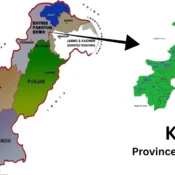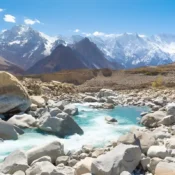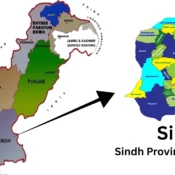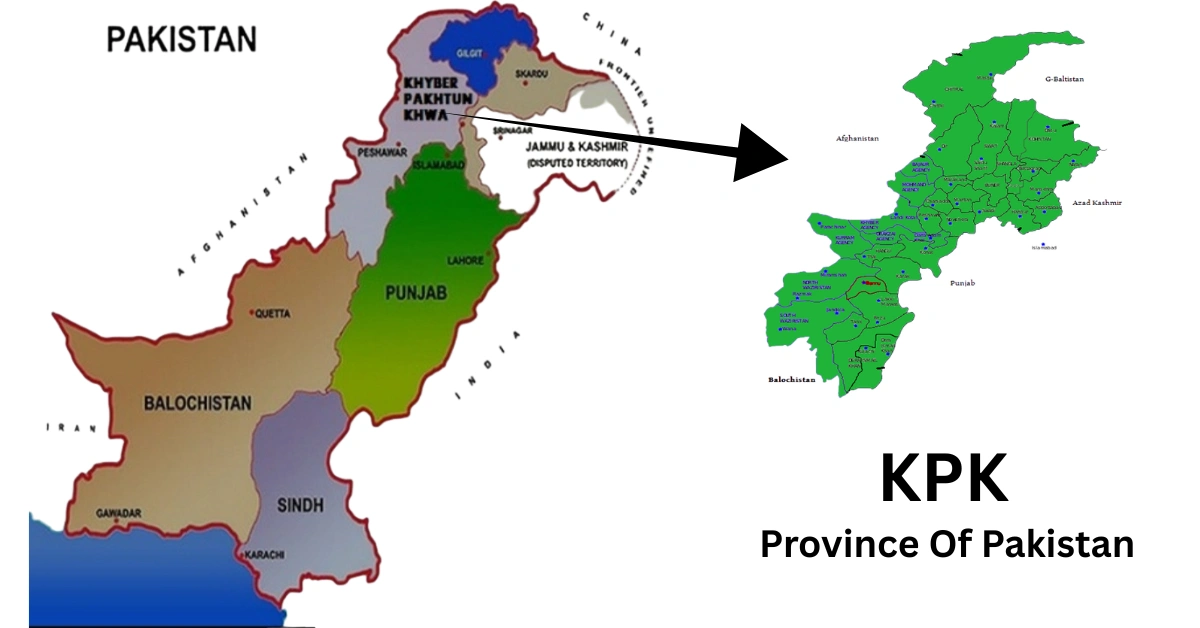
Khyber Pakhtunkhwa – Gateway To Mountains & Culture
Quick Facts About Khyber Pakhtunkhwa (KPK)
- Population: 41.8 million in 2025 (estimated based on a 2.3% annual growth rate from the 2023 Census report)
- Area: 101,741 km² — Pakistan’s third-largest province by size
- Capital: Peshawar — one of South Asia’s oldest continuously inhabited cities
- Major Rivers: Kabul River, Swat River, Kunhar River
- Languages: Pashto (widely spoken), Hindko, Chitrali, Kohistani, Urdu & English in urban areas
- Literacy Rate: 51.1% overall (Economic Survey 2024–25)
- Natural Wealth: Home to 3,000 glaciers and countless rivers feeding Pakistan’s water system
Fact: KPK is called the “gateway to Central Asia,” connecting Pakistan to Afghanistan and beyond through the historic Khyber Pass.
Khyber Pakhtunkhwa – Land of Mountains & Gateways
Khyber Pakhtunkhwa, often called KPK, is where Pakistan meets the mountains. It’s a land where snow-capped peaks guard emerald valleys, where the mighty Indus and its tributaries roar through deep gorges, and where ancient trade routes still echo with history.
The province is not just geography — it’s identity. From the Khyber Pass, once the main gateway for traders, travelers, and invaders entering South Asia, to the lush valleys of Swat, Kaghan, and Chitral, KPK has always been a meeting point of cultures and civilizations.
KPK is Pakistan’s third most populous province, celebrated for its Pashtun heritage, hospitality, and courage. Its people live by the code of Pashtunwali, a tradition rooted in honor, loyalty, and hospitality that still shapes daily life.
For adventurers, KPK is paradise: trekking in the Hindu Kush, skiing in Malam Jabba, camping in Kumrat, rafting in the Swat River, or standing at the top of Shandur Pass, the “Roof of the World,” during its famous polo festival. And for historians, it’s a living museum, from Gandhara’s Buddhist relics in Takht-i-Bahi to Mughal forts and British-era cantonments.
Fact: KPK is home to 3,000+ glaciers, more than any other province in Pakistan — making it the country’s biggest source of fresh water.
History & Heritage
The history of Khyber Pakhtunkhwa is as old as the mountains that guard it. For thousands of years, this rugged land has stood as a gateway between Central Asia and the Indian subcontinent, where armies, traders, and pilgrims passed through its legendary passes, leaving behind traces of their journeys.
One of the most remarkable chapters belongs to the Gandhara Civilization, which flourished here nearly two thousand years ago. In cities like Takht-i-Bahi near Mardan, great Buddhist monasteries rose against the hills, attracting scholars and pilgrims from across Asia. The Gandhara art style, with its serene Buddha sculptures carved in Greco-Roman fashion, became one of the region’s most enduring legacies. Today, the ruins of Takht-i-Bahi are recognized as a UNESCO World Heritage Site, a reminder of KPK’s place at the crossroads of cultures and faiths.
Centuries of history marched through the Khyber Pass. From Alexander the Great in 327 BCE to the Persian kings, Kushan emperors, and Turkic rulers, every empire sought to control this strategic land. Later, the arrival of Islam in the 8th to 11th centuries transformed the region, carried by Arab traders, Sufi saints, and Afghan rulers. Pashtun tribes gradually became the soul of the province, proud of their independence, hospitality, and unwavering traditions.
During the Mughal era, Khyber Pakhtunkhwa was dotted with forts and caravan routes, acting as both protective strongholds and gateways of trade. In the 19th century, the region became a focal point during the Anglo-Afghan wars, remembered for its strategic importance and resilient tribal communities. By 1901, the British formally named it the North-West Frontier Province (NWFP), a title it carried for more than a century until 2010, when it was officially renamed Khyber Pakhtunkhwa.
At Partition in 1947, the people of this region chose to join the new state of Pakistan after a referendum. Since then, KPK has remained a land of resilience, a province that has seen both hardship and hope, standing as a frontline during the Afghan wars while continuing to nurture its culture, heritage, and role in Pakistan’s identity.
Fact: The Buddhist ruins of Takht-i-Bahi in Mardan, dating back to the 1st century CE, are among the most important Buddhist remains in the world and still attract researchers and visitors alike.
Geography & Climate
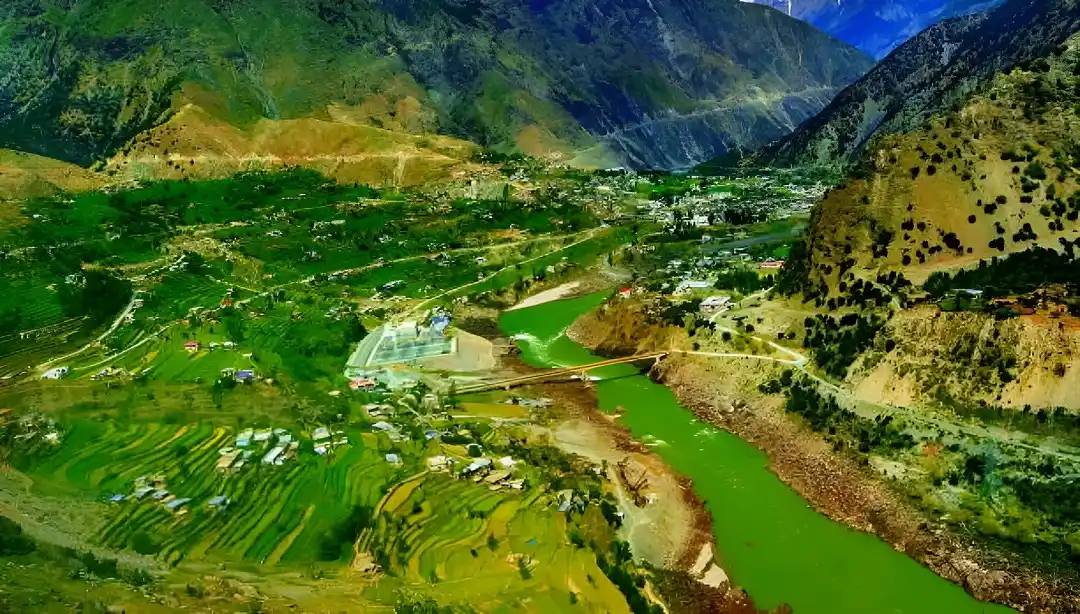
Khyber Pakhtunkhwa stretches across some of Pakistan’s most dramatic landscapes, from towering mountains and lush valleys to arid plains and historic passes. Covering 101,741 km² (KPK Government), it accounts for about 12.6% of Pakistan’s total area and is home to more than 41.8 millio people (2025 estimated).
-
Mountains & Valleys – Where Peaks Touch the Sky
The northern districts of KPK rise into the mighty Himalayas, Hindu Kush, and Karakoram ranges. This region is home to Tirich Mir (7,690 m), the highest peak of the Hindu Kush, and dozens of other snow-capped giants that dominate the skyline. Between these peaks lie valleys like Swat, Chitral, Kalam, and Kaghan, often called the “Switzerland of the East” for their alpine beauty.
-
Rivers – The Lifelines of KPK
The Indus River cuts through the province, joined by tributaries like the Kabul, Swat, and Kunhar rivers, which not only shape the land but also sustain agriculture, hydropower, and daily life. These rivers are also a playground for adventure seekers, offering some of Pakistan’s best white-water rafting and fishing opportunities.
-
Plains & Passes – Gateways of History
To the south, the land flattens into plains and semi-arid zones, where agriculture flourishes around wheat, sugarcane, and tobacco. The famous Khyber Pass, historically the gateway between South and Central Asia, remains one of the world’s most legendary mountain passes, carrying tales of conquerors, caravans, and cultural exchange.
-
Climate – From Alpine to Arid
The province experiences diverse climates. In the north, summers are cool and winters bring heavy snow, turning valleys like Naran and Malam Jabba into winter wonderlands. Central districts have mild summers and crisp winters, while the south is hot and dry, with temperatures rising above 40°C in D.I. Khan during peak summer. This climatic diversity makes KPK a year-round destination, skiing in winter, trekking in spring, and rafting in summer.
Fact: The Tirich Mir Peak (7,690 m) in Chitral is the highest mountain outside the Himalayas and Karakoram ranges, making it the tallest in the entire Hindu Kush range.
People & Culture
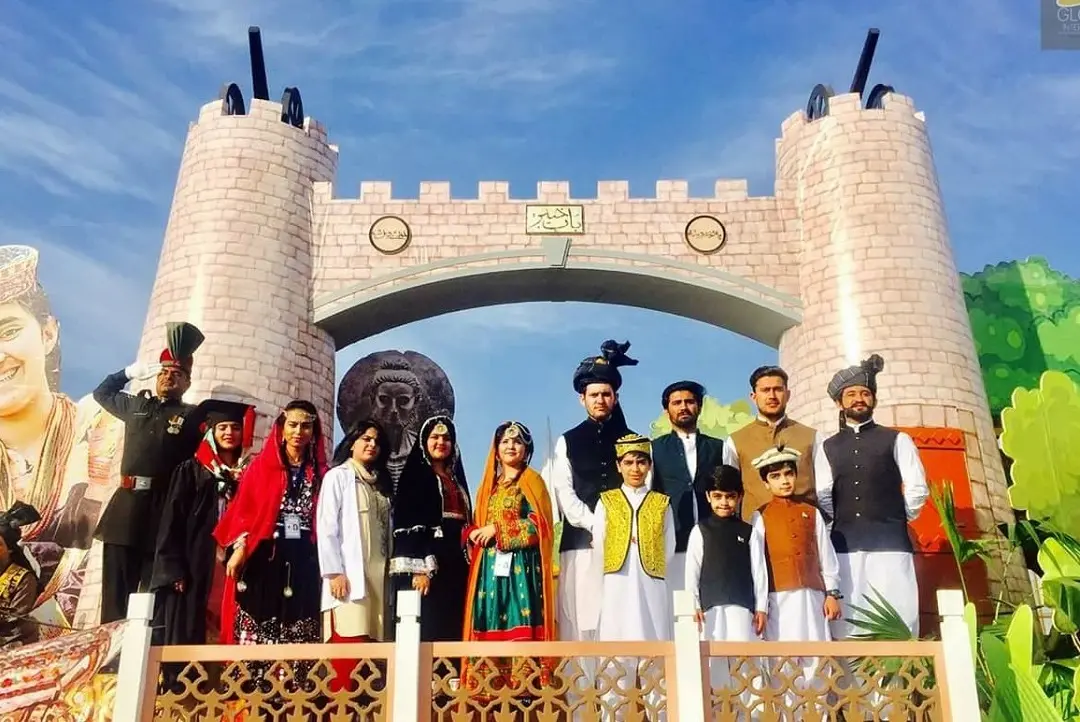
Khyber Pakhtunkhwa’s culture is defined by the warmth of its people, the strength of tribal traditions, and the echoes of poetry and music that flow through its valleys. Life here is built on hospitality, honor, and a deep connection to both land and history.
-
Pashtun Hospitality & Traditions
Pashtuns, the largest ethnic group of KPK, are renowned for melmastia (hospitality) and badal (justice/revenge), values enshrined in the traditional Pashtunwali code. Guests are treated with great respect, often welcomed with green tea, dried fruits, and home-cooked meals. The Jirga system, an assembly of elders, still plays a vital role in resolving community disputes through consensus.
-
Languages of KPK
- Pashto – The dominant language, spoken across most districts.
- Hindko – Widely spoken in Hazara Division (Abbottabad, Mansehra).
- Chitrali (Khowar) – Native to Chitral Valley.
- Kohistani & Others – Smaller mountain communities preserve unique dialects.
- Pashto – The dominant language, spoken across most districts.
-
Festivals & Celebrations
KPK’s cultural calendar blends seasonal, spiritual, and tribal festivities:
- Nowruz (Spring Festival): Celebrated in Chitral and northern areas, marking the arrival of spring.
- Jashn-e-Chitral: A vibrant festival of polo, dance, and music against the backdrop of Tirich Mir.
- Urs of Sufi Saints: Shrines like Akhund Darweza in Swabi draw thousands of devotees, echoing with qawwali and Sufi poetry.
- Nowruz (Spring Festival): Celebrated in Chitral and northern areas, marking the arrival of spring.
-
Handicrafts & Artistry
The province is known for crafts that have reached global fame:
- Peshawari Chappal: Handmade leather sandals worn across Pakistan and beyond.
- Carpets & Rugs: Handwoven with geometric patterns, especially in tribal regions.
- Woodwork: Intricate carvings from Swat and Charsadda decorate doors, furniture, and mosques.
- Peshawari Chappal: Handmade leather sandals worn across Pakistan and beyond.
-
Poetry & Literature
KPK’s spirit lives in its poetry. Legendary poets like Khushal Khan Khattak championed freedom, valor, and justice, while Rahman Baba remains beloved for his spiritual verses, recited in hujras (community gathering places) and Sufi shrines. Their works continue to inspire Pashto music and literature.
Fact: The Kalash people of Chitral Valley celebrate unique seasonal festivals like Chilam Joshi, which are among the few pre-Islamic traditions still alive in South Asia.
Food – Taste Of KPK
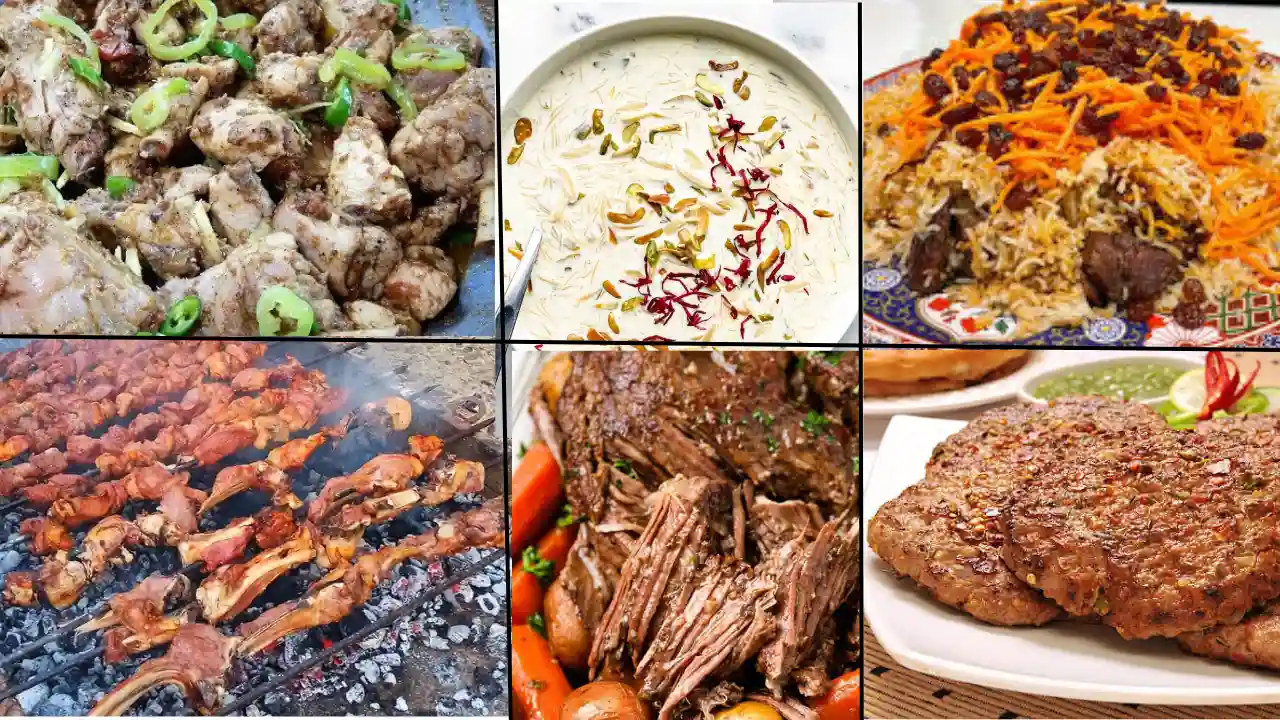
Food in Khyber Pakhtunkhwa is more than just nourishment — it is a reflection of hospitality, tribal identity, and centuries of trade and tradition along the Silk Road. Strong flavors, generous use of meat, and slow-cooked recipes define the cuisine, often served in portions large enough to welcome a guest as family.
-
Signature Dishes
- Chapli Kebab: A crispy, spiced minced meat patty fried in oil, originally from Peshawar, now famous across Pakistan and Afghanistan.
- Kabuli Pulao: Rice cooked with raisins, carrots, and lamb, reflecting Afghan influence. It’s both festive and everyday comfort food.
- Namak Mandi Karahi: A specialty of Peshawar’s historic Namak Mandi bazaar, this karahi is made with minimal spices to let the rich flavor of lamb or mutton shine.
- Shinwari Tikka: Large chunks of lamb grilled over open flames, seasoned only with salt, representing the Pashtun love for simplicity and purity of flavor.
- Chapli Kebab: A crispy, spiced minced meat patty fried in oil, originally from Peshawar, now famous across Pakistan and Afghanistan.
-
Sweets & Desserts
- Jalebi: Crispy spirals soaked in sugar syrup, a common street sweet.
- Sheer Khurma: A milk-based vermicelli dessert, especially popular during Eid celebrations.
- Gur-based sweets (jaggery): In rural areas, sweets made from jaggery and nuts are common in winter.
- Jalebi: Crispy spirals soaked in sugar syrup, a common street sweet.
-
Tea & Drinks Culture
Tea, especially Qehwa (green tea with cardamom, sometimes saffron or nuts), is central to KPK’s hospitality. No gathering, whether in a hujra (guest house) or a roadside dhaba, is complete without steaming cups of qehwa shared among friends and strangers alike.
-
Street Food of Peshawar
Peshawar is the culinary heart of KPK. Its bazaars overflow with sizzling chapli kebabs, piping-hot naans, fried fish, and kababs served with chutneys. Namak Mandi at night becomes a feast for the senses, where smoke, spices, and laughter fill the air.
-
Other Must-Try Specialties
- Roash (Dumpukht): Meat slow-cooked in its own fat, a delicacy for weddings and large gatherings.
- Karahi from Landi Kotal: A frontier specialty with bold, smoky flavors.
- Dry fruits & nuts: Chitrali almonds, pine nuts, and dried mulberries are winter favorites and symbols of hospitality.
- Roash (Dumpukht): Meat slow-cooked in its own fat, a delicacy for weddings and large gatherings.
From Peshawar’s smoky kebab stalls to the quiet valleys of Chitral, every flavor in Khyber Pakhtunkhwa carries a story of warmth and tradition. Food here is more than a meal, it’s hospitality, pride, and culture served with every cup of qehwa and every sizzling chapli kebab.
Festivals & Celebrations
KPK’s festivals reflect its cultural diversity, from ancient pagan rituals in the Kalash Valleys to the adrenaline of polo matches at the world’s highest polo ground, to Islamic traditions that unite the province. Each festival is not just an event but a celebration of identity, community, and resilience.
-
Jashn-e-Chitral & Shandur Polo Festival
At Shandur Pass (3,700 m) lies the world’s highest polo ground, where teams from Chitral and Gilgit face off in the Shandur Polo Festival every July. It’s more than a game, it’s a cultural carnival featuring folk music, camping under starry skies, and vibrant dances. Similarly, Jashn-e-Chitral showcases local traditions, handicrafts, and the warmth of mountain hospitality.
-
Kalash Festivals
The Kalash people of Chitral celebrate some of Pakistan’s most unique and colorful festivals:
- Chilam Joshi (May): Welcomes spring with dancing, bonfires, and music.
- Uchal (August): A harvest festival thanking the gods for crops and livestock.
- Choimus (December): A winter solstice celebration marking purification, renewal, and community bonding.
These festivals, with their ancient rituals, vibrant costumes, and music, attract visitors worldwide.
- Chilam Joshi (May): Welcomes spring with dancing, bonfires, and music.
-
Religious & Spiritual Celebrations
- Eid-ul-Fitr & Eid-ul-Adha: Celebrated across KPK with communal prayers, feasts, and acts of charity.
- Sufi Urs: Annual gatherings at shrines, such as Rehman Baba’s shrine in Peshawar, where poetry, qawwali, and devotion merge.
- Nowruz: Celebrated by Persian-influenced communities, especially in Chitral and Kohat, marking the Persian New Year and arrival of spring
- Eid-ul-Fitr & Eid-ul-Adha: Celebrated across KPK with communal prayers, feasts, and acts of charity.
Fact: The Shandur Polo Festival attracts over 20,000 visitors annually, making it one of Pakistan’s biggest mountain tourism events.
Cities Of KP
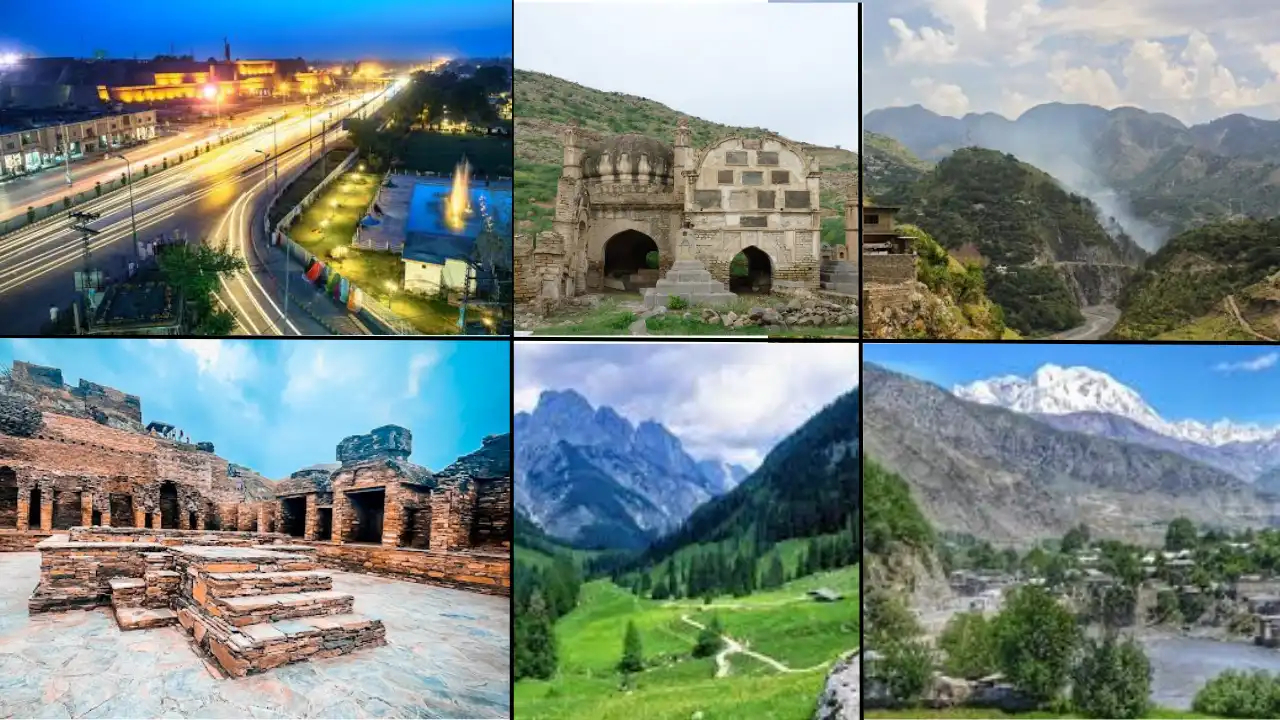
KPK’s cities are gateways to history, culture, and natural wonders. From the bustling bazaars of Peshawar to the serene valleys of Chitral, each city has its own rhythm, flavor, and legacy.
-
Peshawar – The Ancient Frontier City
One of South Asia’s oldest cities, Peshawar blends history with modern vibrance. From the Qissa Khwani Bazaar (Market of Storytellers) to the iconic Bala Hisar Fort, the city is a living museum of trade, culture, and conquest. Its Namak Mandi food street is legendary for chapli kebabs and karahi.
Population: 2.55 million (estimated population by macrotrends)
Fact: Peshawar is over 2,500 years old, once part of the Gandhara Civilization. -
Mardan – The Heart of Gandhara
Known for its proximity to the Takht-i-Bahi Monastery (a UNESCO World Heritage Site), Mardan is a hub of agriculture and industry. It is famous for sugarcane, tobacco, and delicious sweets like Patisa.
Population: 423,000 (estimated population by macrotrends)
Fact: Takht-i-Bahi is one of the best-preserved Buddhist monastic complexes in the world. -
Abbottabad – The Gateway to the North
Nestled in the Hazara region, Abbottabad is surrounded by pine-covered hills and colonial-era buildings. It serves as a key stop for travelers heading to Kaghan, Naran, and Gilgit-Baltistan.
> Population: 1.44 million (estimated based on a 1.05% annual growth rate from the 2023 Census report)
Traveler’s Tip: Abbottabad is famous for its schools and military academy — the Pakistan Military Academy at Kakul.
-
Swat – Switzerland of the East
Swat Valley’s main towns – Mingora and Saidu Sharif – are cultural and commercial centers. Known for lush valleys, Buddhist relics, and ski slopes, Swat is a blend of natural and historical beauty.
> Population: 2.82 million (estimated based on a 2.56% annual growth rate from the 2023 Census report)
Fact: Swat is home to the remains of the Gandhara Buddhist civilization, with over 1,000 archaeological sites. -
Chitral – Land of Peaks & Cultures
A high-mountain valley town, Chitral lies under the shadow of Tirich Mir (7,708 m), the highest peak of the Hindu Kush. Known for its polo grounds, Kalash culture, and rich music traditions, Chitral is a jewel of KPK.
> Population: 540,000 (Total Upper and Lower Destricts, estimated based on a 2.42% annual growth rate from the 2023 Census report)
Fact: Chitral’s Kalash Valleys are home to one of the world’s most unique indigenous cultures. -
Kohat – City of Hills & Springs
Famous for its natural springs and beautiful surroundings, Kohat is also a garrison city. Its bazaars are popular for dried fruits, especially Kohat’s famous guavas.
> Population: 1,290,000 (estimated based on a 2.38% annual growth rate from the 2023 Census report)
Fact: Kohat Tunnel, linking Kohat to Peshawar, is the longest road tunnel in Pakistan (1.9 km). -
Dera Ismail Khan (DI Khan) – Gateway to the South
Located near the Indus River, DI Khan blends agricultural wealth with tribal traditions. The city is famous for mangoes and dates, and it serves as a southern entry point to KPK.
> Population: 1,878,000 (estimated based on a 1.30% annual growth rate from the 2023 Census report)
Traveler’s Tip: DI Khan’s dates are among the sweetest in Pakistan.
Khyber Pakhtunkhwa’s story doesn’t end with its major cities. Beyond these hubs, smaller towns and valleys carry their own beauty and spirit – Haripur, with its orchards and proximity to Khanpur Dam; Mansehra, the gateway to the majestic Kaghan Valley; Bannu, known for its traditions and savory Bannu Pulao; and Karak, rich with natural resources and cultural pride. Each settlement, whether tucked in the mountains or spread across fertile plains, adds a vibrant stroke to KPK’s canvas of history, resilience, and natural splendor – making the province not just a region, but a living tale of people, culture, and landscapes.
Economy
Khyber Pakhtunkhwa is steadily stepping into its role as a vital economic player in Pakistan. In the 2024–25 budget, the province laid out a total revenue plan of Rs 1,754 billion with a surplus of Rs 100 billion, demonstrating growing fiscal confidence. Wikipedia Meanwhile, the 2025-26 budget aims even higher — Pak authorities expect stronger revenues, a substantial development outlay, and a record surplus. Dawn
-
Agriculture & Rural Economy
Agriculture remains the backbone of KPK’s economy. Fields of wheat, maize, tobacco, rice, and fruit orchards spread across the province, feeding both local markets and export channels.(Wikipedia). Rural development projects, such as those funded by IFAD, aim to modernize farming methods and boost incomes in mountain and valley areas. IFAD
-
Industry, Mining & Special Economic Zones
While industry is smaller compared to provinces like Punjab or Sindh, KPK is making strides. The province holds a large share of Pakistan’s mineral production and marble output (Wikipedia). To spur industrial growth, the Rashakai Special Economic Zone (SEZ) launched in Nowshera under the CPEC framework is one of KPK’s flagships, offering incentives for manufacturing and trade. The mining sector is also under renewed focus, with the Khyber Pakhtunkhwa Mines and Minerals Bill, 2025 currently in discussion to standardize licensing and attract investment.
-
Hydropower & Energy Projects
KPK’s energy sector is undergoing transformation, with hydropower at the frontline. The Suki Kinari Hydropower Project on the Kunhar River (Mansehra district) became operational in September 2024, with 884 MW capacity, adding significant power to the national grid Wikipedia. This is a major boost in harnessing the province’s river potential under the China-Pakistan Economic Corridor (CPEC) umbrella. CPEC
-
Services, Trade & Commerce
Services and trade, especially in urban hubs like Peshawar and Abbottabad, contribute steadily to the provincial economy. The bazaars of KPK – from Peshawar’s historic markets to the trading routes in Mardan – facilitate internal commerce and cross-border trade Wikipedia. The export landscape is improving too, as detailed in the Trade Development Authority’s 2025 report, highlighting growing contributions from produce, processed goods, and regional crafts TDAP.
KPK may not yet dominate Pakistan’s economy, but its growth trajectory is clear. From fertile valleys yielding crops, to hydropower plants lighting towns, and trade zones unlocking industrial potential — the province is weaving a more diversified, resilient future. With continued investment in infrastructure, industry, and energy, KPK is steadily transforming its natural assets into economic pillars.
| Sector | Role & Contribution | Latest Key Stats |
|---|---|---|
| Agriculture | Backbone of rural KPK economy | Employs ~44 % of KPK’s labour force; contributes ~22 % of provincial GDP FAOLEX |
| Energy (Hydropower) | Rivers powering new dams & grid contribution | Suki Kinari HPP (884 MW) was commissioned in September 2024 and is now operational cpec.gov.pk |
| Mining & Minerals | Mineral reserves & marble, gem production | KPK contributes 20 % of Pakistan’s mining output Wikipedia |
| Services & Trade | Urban markets, commerce, regional trade | Services sector dominates provincial economy (approx. 67 %) GTAI |
Education in Khyber Pakhtunkhwa
Khyber Pakhtunkhwa has long been known for its resilience in education despite challenges of geography and conflict. From bustling campuses in Peshawar to academic hubs in Mardan and Abbottabad, the province is steadily building a reputation as a center of learning and research.
As of the Pakistan Economic Survey 2024–25, KPK’s literacy rate stands at 51%, slightly below the national average, but with strong growth in urban areas and female education initiatives.
Key Universities & Rankings
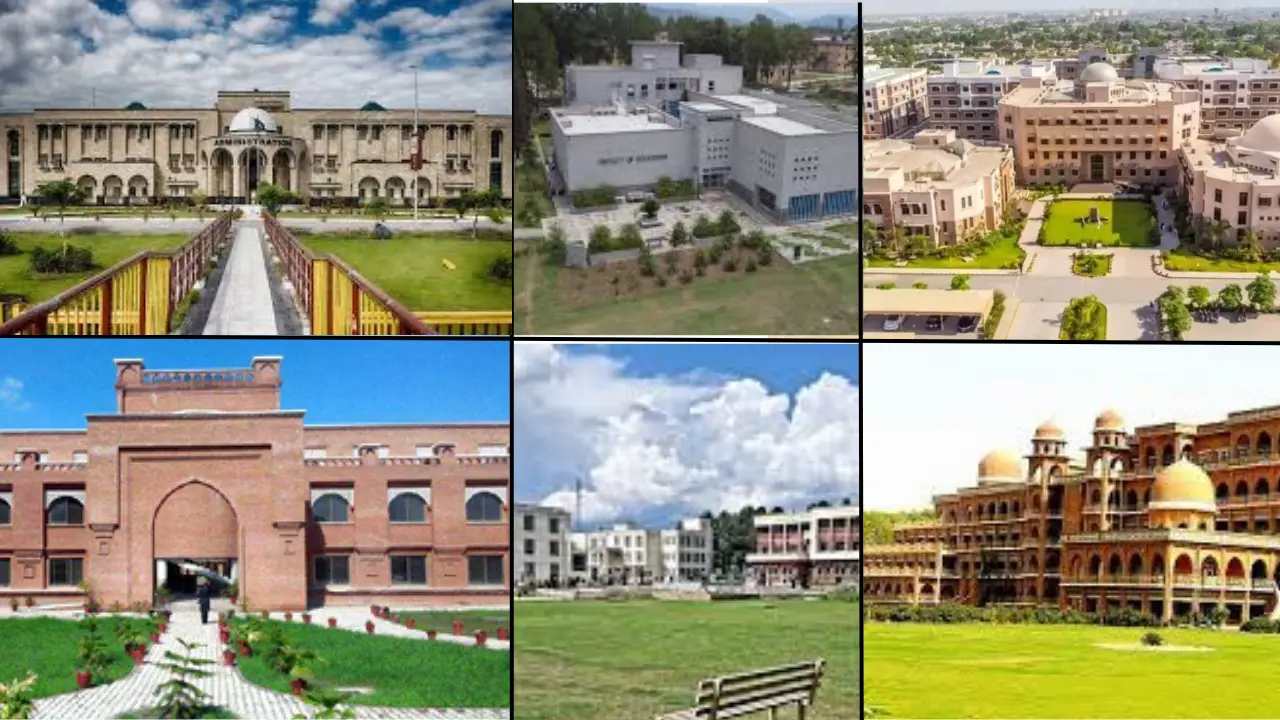
-
University of Peshawar (est. 1950, Peshawar)
One of Pakistan’s oldest and most prestigious universities, offering programs across humanities, sciences, and law. Ranked in Times Higher Education Asia Impact Rankings 2025 for contributions to Sustainable Development Goals.
-
University of Engineering & Technology (UET) Peshawar (est. 1980, Peshawar)
Specializes in engineering and applied sciences, with strong research in civil, mechanical, and mining engineering. Appeared in QS Asia University Rankings 2025 in the Top 500.
-
Khyber Medical University (KMU, est. 2007, Peshawar)
The leading medical university of the province, with multiple affiliated teaching hospitals. Known for health sciences research and producing top doctors.
-
Abdul Wali Khan University (AWKU, est. 2009, Mardan)
Rapidly growing institution, recognized in THE Asia Ranking 2025 for social sciences and community outreach.
-
Hazara University (est. 2002, Mansehra)
Situated in scenic Hazara, known for its research in forestry, biodiversity, and Himalayan ecology.
-
University of Malakand (est. 2001, Lower Dir)
Plays a key role in expanding higher education access in northern KPK, especially in remote regions.
-
Institute of Management Sciences (IMSciences, Peshawar)
One of Pakistan’s leading management schools, ranked in the Top 300 in Asia for Business & Management Studies (QS 2025).
Quick Fact: Peshawar, the capital of KPK, is often called the province’s “Education Hub”, hosting the largest cluster of universities and research centers in the region.
Education in Khyber Pakhtunkhwa is not just about institutions, it’s about resilience and growth. From historic campuses in Peshawar to emerging universities in Mardan, Malakand, and Hazara, the province is steadily nurturing talent that contributes to Pakistan’s future. While challenges in access and literacy remain, KPK’s focus on expanding higher education, medical sciences, and technical fields ensures that learning is reaching even its remotest valleys. Step by step, the province is shaping a new generation ready to carry its legacy of strength, culture, and knowledge forward.
Arts, Handicrafts & Entertainment
Khyber Pakhtunkhwa is a province where creativity runs deep, rooted in centuries of tradition yet alive with modern expression. Its crafts, music, and performances reflect the resilience and artistry of its people.
-
Handicrafts – Skill Passed Through Generations
- Peshawari Chappal: World-famous handcrafted leather sandals, now worn from village markets to international runways.
- Carpets & Rugs: Intricate handwoven carpets from Swat, Bannu, and Kohat are admired for their durability and geometric designs.
- Woodwork: Skilled artisans carve doors, furniture, and decorative pieces, particularly in Charsadda and Swat.
- Embroidery: Colorful needlework on shawls, caps, and dresses showcase regional identity, especially in Chitrali and Hazara communities.
-
Music & Poetry – The Soul of KPK
Music here is as much about storytelling as it is about rhythm.
- Pashto Folk Music: Instruments like the rabab and tabla accompany folk songs passed down generations.
- Poetry: Legends like Khushal Khan Khattak and Rahman Baba gave Pashto literature a voice of bravery, love, and mysticism. Their verses are still sung and recited in homes and cultural gatherings.
- Qawwali & Sufi Music: In towns like Peshawar and Mardan, devotional music echoes in Urs celebrations.
-
Entertainment – Tradition Meets Modernity
- Theatre & Cinema: Peshawar has been the historical hub of Pashto cinema (Pollywood), once producing hundreds of films annually.
- Festivals: Cultural fairs (melas) bring together music, poetry recitals, and folk dances like attan, the spirited Pashtun group dance symbolizing unity and celebration.
- Sports & Shows: Local wrestling (pehlwani) matches and polo in northern valleys are not just entertainment but traditions woven into community life.
Quick Fact: The attan dance, performed in circles to the beat of drums, is so deeply rooted in Pashtun culture that it is often performed at weddings, festivals, and even on battlefields as a symbol of pride and strength.
Sports in Khyber Pakhtunkhwa
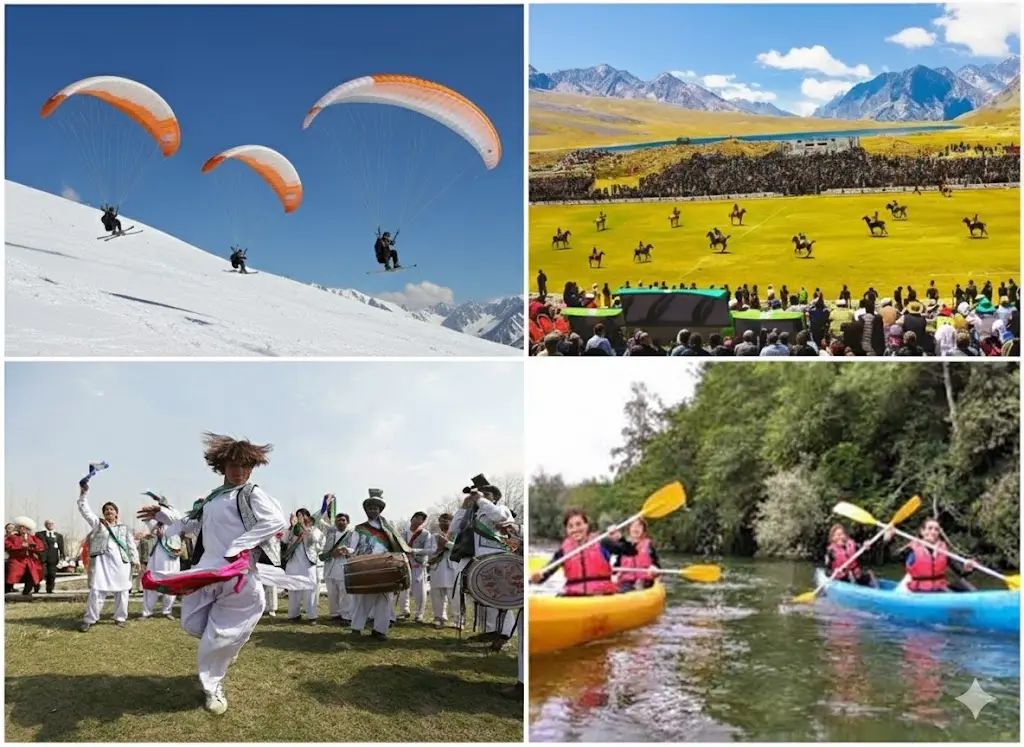
Sports in Khyber Pakhtunkhwa are more than just games – they are a reflection of the province’s energy, resilience, and communal spirit. From traditional Pashtun sports played in dusty fields to international cricket matches in Peshawar, KPK’s sporting culture bridges heritage and modern passion.
Traditional Games – The Roots of Play
- Attan & Dance Games: Beyond music, attan doubles as a group performance that demands stamina and coordination, embodying a mix of play and cultural pride.
- Kabaddi: Played in villages across Hazara and Peshawar Valley, kabaddi combines strength, strategy, and teamwork.
- Wrestling (Pehlwani): Strongmen gather in local arenas, especially in Mardan and Peshawar, where matches draw enthusiastic crowds.
- Polo in Chitral: At Shandur, the world’s highest polo ground, polo is not just a game but a centuries-old tradition celebrated with festivals and music.
Modern Sports – From Fields to Stadiums
- Cricket: The most popular sport in KPK. Peshawar Zalmi, the PSL franchise, has turned cricket into a unifying identity for young fans. Arbab Niaz Stadium in Peshawar is set to become an international cricket hub after major renovations.
- Hockey: Once Pakistan’s national pride, hockey still thrives in KPK with local clubs and school tournaments.
- Football: Chitral and Swat valleys are emerging hubs for football talent, with local leagues gaining recognition.
Adventure Sports – Born from the Mountains
- Mountaineering & Trekking: With peaks like Tirich Mir and ranges like Hindu Kush, the province offers endless adventure opportunities.
- Rafting & Kayaking: Rivers like Kunhar and Swat attract water-sport enthusiasts.
- Paragliding & Skiing: Malam Jabba has revived Pakistan’s winter sports, with facilities for skiing, snowboarding, and paragliding.
Quick Fact: The Shandur Polo Festival, held annually at an altitude of around 3,700 meters, is one of the highest polo tournaments in the world, drawing players and spectators from across Pakistan and beyond.
Places to Visit in KP
Khyber Pakhtunkhwa is only province of Pakistan’s where nature, history, and adventure meet. From the serene valleys of Swat to the ancient passes of Khyber, every corner tells a story of resilience and timeless beauty. The province is home to majestic mountains, sparkling lakes, and living cultures that make it one of Pakistan’s most captivating destinations.
-
Swat Valley – The Switzerland of the East
Renowned for its lush meadows, waterfalls, and snow-capped peaks, Swat Valley offers a perfect mix of peace and adventure. Mingora and Malam Jabba attract travelers year-round, whether for hiking in summer or skiing in winter.
-
Kalash Valleys – A Living Civilization
Hidden in the Chitral district, the Kalash Valleys — Bumburet, Rumbur, and Birir — are home to the Kalash people, a unique non-Muslim indigenous community celebrated for their colorful festivals, wooden homes, and ancient traditions.
-
Chitral & Tirich Mir – The Roof of the Hindu Kush
Nestled at the base of the mighty Tirich Mir, the highest peak in the Hindu Kush, Chitral offers unmatched serenity, adventure, and cultural depth. Its landscapes, traditional music, and mountain charm make it one of KPK’s crown jewels.
-
Shandur Pass & Polo Ground – Game on the Roof of the World
At an altitude of 3,700 meters, Shandur hosts the world’s highest polo ground. Every July, the Shandur Polo Festival turns this remote plateau into a spectacle of competition, culture, and breathtaking scenery.
-
Naran & Kaghan Valleys – Nature’s Paradise
With alpine lakes, lush meadows, and scenic drives, the Naran and Kaghan Valleys are a haven for summer travelers. From trout fishing to mountain treks, the region offers something for every nature lover.
-
Malam Jabba – The Winter Wonderland
Pakistan’s premier ski resort, Malam Jabba, combines snow-clad slopes with modern facilities for skiing, snowboarding, and chairlift rides — all against a panoramic mountain backdrop.
-
Khyber Pass – Gateway of Empires
Once a crucial part of the Silk Road, the historic Khyber Pass connects Pakistan with Afghanistan. Its winding roads and ancient forts tell tales of traders, conquerors, and empires that shaped South Asia.
-
Takht-i-Bahi – The Buddhist Legacy
A UNESCO World Heritage Site, Takht-i-Bahi is an ancient Buddhist monastery dating back to the 1st century CE. Its stone ruins, perched on a hill near Mardan, are among the best-preserved in the world.
-
Taxila – The Crossroads of Civilizations
Shared by KPK and Punjab, Taxila was once a center of Buddhist learning and Gandhara art. Its stupas, monasteries, and museum offer deep insight into ancient scholarship and spirituality.
-
Saif-ul-Malook Lake – The Lake of Legends
Located near Naran, this stunning alpine lake is wrapped in folklore and surrounded by towering peaks. Locals still tell the mystical tale of Prince Saif and the fairy Badi-ul-Jamal under starlit skies.
-
Kumrat Valley – Nature Untamed
A hidden gem in Upper Dir, Kumrat enchants with deodar forests, waterfalls, and crystal rivers. Ideal for trekking and camping, it’s perfect for those seeking untouched beauty away from the crowds.
-
Mahodand Lake – Reflections of the Sky
In Upper Swat, Mahodand Lake shimmers beneath alpine peaks, offering trout fishing, boating, and breathtaking serenity — a picture-perfect destination for nature lovers.
Khyber Pakhtunkhwa’s magic lies not just in its landscapes but in its spirit — a harmony of adventure, culture, and timeless grace. Beyond its famous valleys and lakes lie countless hidden treasures: Dir’s alpine meadows, Buner’s sacred relics, Kohat’s rugged hills, and Dera Ismail Khan’s desert charm. Each town, pass, and peak adds a new layer to the province’s identity, making KPK not merely a destination but a journey through Pakistan’s living history and unspoiled natural wonder.
Incredible Facts
Khyber Pakhtunkhwa isn’t just a land of mountains — it’s a province where history, culture, and nature converge in breathtaking harmony. Here are some fascinating facts that reveal its uniqueness:
-
Home of the Kalash People: The Kalash Valleys of Chitral preserve one of the world’s last remaining polytheistic cultures, known for their colorful festivals and ancient rituals.
-
Land of Glaciers: With over 3,000 glaciers, KPK holds Pakistan’s largest freshwater reserves after Gilgit-Baltistan — a lifeline for the country’s rivers and ecosystems.
-
Shandur Polo Ground: Perched at 3,700 meters, Shandur is recognized as the highest polo ground in the world, hosting a legendary festival each summer.
-
Cradle of Gandhara Civilization: Ancient Buddhist monasteries like Takht-i-Bahi and Sahr-i-Bahlol made KPK a global center of art, learning, and spirituality.
-
Gemstone Capital: KPK produces some of the world’s most sought-after gems — peridot, aquamarine, and topaz — exported to international jewelry markets.
-
Gateway to Central Asia: Through the historic Khyber Pass, the province has linked South Asia with Central Asia for millennia, shaping trade and culture.
-
Education & Progress: Peshawar, the provincial capital, is known as the “Education Hub of the North,” home to prestigious universities and research centers.
-
Adventure Heaven: From skiing in Malam Jabba to trekking in Kumrat Valley and rafting the Swat River, KPK stands as Pakistan’s ultimate adventure destination.
Khyber Pakhtunkhwa’s blend of ancient heritage, rugged landscapes, and warm-hearted people makes it one of Pakistan’s most captivating provinces — a place where every mountain holds a story, and every valley echoes with life.
Conclusion:
Khyber Pakhtunkhwa stands as a place where every summit, valley, and tradition comes alive. From the ancient Buddhist monasteries of Takht-i-Bahi to the festival grounds of Shandur, from the serene lakes of Swat to the rugged beauty of the Kalash Valleys, KPK is more than a destination—it’s an experience. Here, nature’s extremes meet cultural depth, and adventure coexists with centuries of heritage.
✨ To truly understand Pakistan is to journey through its lands, people, and stories. Explore more of what makes this country extraordinary:
-
Discover the full story of Pakistan: Discovering Pakistan
-
Dive into Punjab’s vibrant heart: Punjab – The Heart of Pakistan
-
Wander the landscapes and spirit of Sindh: Explore Sindh
-
Seek out adventure in every corner with Adventure in Pakistan
Let every blog guide you to new horizons—lands to explore, stories to live, and beauty to share.
Frequently Asked Questions
Q1: What is the population of Khyber Pakhtunkhwa province in Pakistan, and what are the main ethnic groups?
Ans: As of the 2023 Census, Khyber Pakhtunkhwa’s population is ~40.85 million, projected to exceed 41 million in 2025. The majority are Pashtuns, with Hindkowans, Chitralis, Kohistanis, and other mountain communities adding cultural diversity.
Q2: What is the origin of the name Khyber Pakhtunkhwa, and why was it changed from North-West Frontier Province (NWFP)?
Ans: The name “Khyber Pakhtunkhwa” was adopted in 2010 to reflect both the iconic Khyber Pass and the Pashtun majority. Before this, the province was officially called the North-West Frontier Province (NWFP) under British rule and later in Pakistan.
Q3: What was KPK like before 1947, during British rule?
Ans: Before independence, the region was known as NWFP and played a key role in the Anglo-Afghan wars. It was a buffer zone between British India and Afghanistan, home to strategic garrisons, tribal autonomy, and active trade routes through the Khyber Pass.
Q4: Is Khyber Pakhtunkhwa considered part of Pashtunistan?
Ans: KPK is the cultural heartland of Pashtuns, but it is firmly part of Pakistan. While the idea of “Pashtunistan” has historical and cultural roots, most Pashtuns in KPK identify strongly with Pakistan and its national framework.
Q5: What should foreign visitors or journalists know about traveling to Khyber Pakhtunkhwa, including safety advisories?
Ans: Tourists can safely visit popular destinations like Swat, Naran, Kaghan, and Chitral with standard travel precautions. However, regions near the Afghan border (like Waziristan) often require special permits. Checking Pakistan’s official travel advisories is recommended before visiting.

